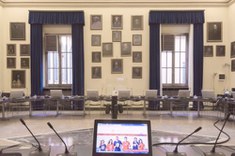Innovation and Cultural Heritage: the Royal Palace of Caserta Mapped in a Single Day with Centimetre Resolution

Thanks to an innovative technology unique in Italy, the historic park of the Royal Palace of Caserta and some outdoor areas have been mapped in a single day with a centimetre scale spatial resolution. This is an extraordinary result, which will make it possible to study the morphology of the park in detail and to define a targeted and sustainable maintenance plan.
The project is the result of a collaboration between the Royal Palace of Caserta and the University of Bologna, involving the Department of Agricultural and Food Sciences - DISTAL, the Department of History and Cultures - DISCI and the Department of Civil, Chemical, Environmental, and Materials Engineering - DICAM.
This is the first time that the technology used - available in our country only at the University of Bologna - has been applied to an Italian historical park, a UNESCO World Heritage Site.
The topographical survey was carried out using high performance mobile mapping technology based on a GNSS satellite positioning system supported by an inertial platform. This was complemented by two laser scanners and a 360° camera. The system was installed on an all-terrain vehicle capable of moving over the area at a speed of 10-15 km/h to ensure capillary and continuous coverage of all areas of the park, the courtyards and the arcade space called the "Cannocchiale".
Updated photographic documentation and a high-resolution three-dimensional model of the area were produced, from which contour lines, elevation points and exposure maps could be extracted. Using the data collected, the researchers are now creating a DTM (Digital Terrain Model) of the natural surface without man-made elements but with vegetation.
The survey was refined by integrating control points defined by GNSS technology in RTK mode, which were useful for verifying and improving the accuracy of the model obtained.
Professors Alberto Minelli (DISTAL), Stefano Gandolfi (DICAM) and Marco Dubbini (DISCI) collaborated on the project and were involved in the production of the high-resolution digital maps. A scientific base of the highest level, which will be able to support the effective management, conservation and enhancement of the Royal Park of the Royal Palace of Caserta in the coming years.






